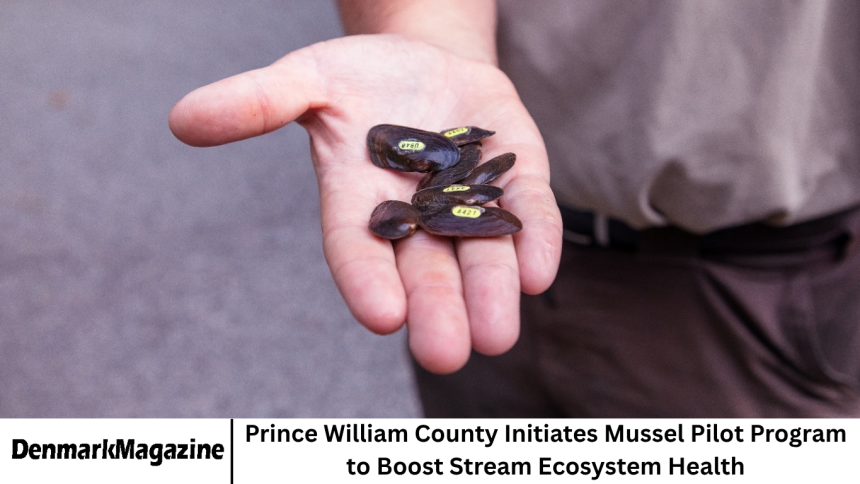Freshwater mussels are not only fascinating creatures but also ecological powerhouses. Each mussel can filter up to 10 gallons of water per day, removing tiny particles, excess nutrients, and pathogens. This natural filtration process helps reduce eutrophication, which occurs when nutrient overload leads to harmful algae blooms.
By filtering water, mussels maintain clarity, oxygen levels, and the delicate balance of aquatic ecosystems. Mussels are also bioindicators, meaning their health reflects the overall condition of the waterway. If mussels are thriving, it’s likely that the stream has clean water, healthy oxygen levels, and diverse aquatic life.
Conversely, a declining mussel population often signals pollution, sedimentation, or other ecological stresses. In a significant stride toward enhancing local water quality and biodiversity, Prince William County, Virginia, has launched a pilot program introducing freshwater mussels into several restored streams.
More Read: Decoding the Chinese Consumer: How Global Brands Blend Data and Culture to Win Over China’s Market
Historical Context of Mussels in Virginia
Historically, Virginia’s streams were abundant with native freshwater mussels. Indigenous communities and early settlers relied on mussels for food, shells, and ceremonial purposes. Over the past century, however, populations declined drastically due to urban development, pollution, dam construction, and habitat fragmentation.
Streams became more turbid, nutrient-rich, and less hospitable to mussels. Prince William County, like many regions in the Chesapeake Bay watershed, has recognized that restoring mussels is not just about reintroducing a species; it’s about rebuilding an entire aquatic ecosystem.
The current pilot program aims to learn from these historical declines and ensure sustainable restoration efforts.
Community Engagement and Education
A key component of the pilot program is community engagement. The County is hosting public workshops, school programs, and citizen science projects to educate residents about the importance of freshwater mussels. Volunteers can help with monitoring water quality, observing mussel cages, and recording environmental data.
According to EMD officials, “Engaging the community is essential. The more people understand the role mussels play in their streams, the more likely they are to protect and preserve local waterways.” This educational angle also provides hands-on environmental learning for students, fostering a new generation of conservation-minded citizens.
Comparative Studies: Mussels in Other Regions
Freshwater mussel restoration is not unique to Prince William County. States like Tennessee, North Carolina, and Pennsylvania have conducted similar programs with measurable success. For instance, in Tennessee, the introduction of native mussels into streams led to a 30% improvement in water clarity and an increase in insect biodiversity within two years.
Prince William County is using these case studies to design a program tailored to local conditions. Key lessons include:
- Selecting mussel species that are native to the area.
- Ensuring host fish populations are robust.
- Regular monitoring to adapt methods as needed.
By learning from other regions, the County hopes to avoid pitfalls and maximize ecological benefits.
Challenges and Risks
While promising, mussel reintroduction comes with challenges. Factors like urban runoff, climate change, invasive species, and low oxygen levels can threaten newly introduced populations. For example, heavy rainfall events can cause sediment to smother mussels or wash them downstream.
To mitigate these risks, the County has implemented protective cages and is conducting ongoing water quality monitoring. Scientists will adjust strategies based on observed survival rates and environmental conditions. This adaptive management approach ensures that the program remains responsive to unforeseen challenges.
The Broader Impact on the Chesapeake Bay
Prince William County’s streams eventually feed into the Potomac River and the Chesapeake Bay, one of the most ecologically and economically important estuaries in the United States. Improving water quality upstream benefits not only local ecosystems but also commercial fisheries, recreational areas, and drinking water sources downstream.
Freshwater mussels act as a natural, low-cost filtration system, complementing traditional stormwater and wastewater management efforts. By restoring these organisms, the County contributes to regional efforts to combat nutrient pollution and maintain the Bay’s ecological health.
Interviews and Expert Insights
Dr. Emily Harding, an aquatic ecologist involved in the project, emphasizes the significance of mussels: “Mussels are living water filters. They remove nutrients, clear water, and provide habitat for other species. Reintroducing them is like giving a river a second chance to thrive.”
County Supervisor Andrea Davis highlights the collaborative nature of the project: “This program represents the best of public-private partnerships. By working with federal agencies, nonprofits, and local volunteers, we’re investing in the long-term health of our streams.”
These insights underscore the blend of science, policy, and community engagement that defines the program.
Next Steps and Future Expansion
The pilot program is just the beginning. Depending on the results over the next 12 to 24 months, Prince William County may expand mussel reintroduction to other streams and tributaries. Future goals include:
- Establishing self-sustaining mussel populations.
- Integrating mussel restoration into broader stream restoration projects.
- Using data from the pilot to guide regional conservation policies.
Long-term success could position Prince William County as a model for freshwater mussel restoration in urban and suburban environments.
Frequently Asked Question
How do mussels improve water quality?
Mussels filter water by removing sediment, algae, bacteria, and excess nutrients, improving clarity and oxygen levels.
Which mussel species are being reintroduced?
The Eastern Elliptio, a native species, is chosen for its ecological benefits and compatibility with local streams.
Why are host fish important?
Mussel larvae (glochidia) attach to fish gills or fins to develop into juvenile mussels. Without host fish, mussels cannot reproduce successfully.
How will the program measure success?
Success metrics include mussel survival, growth, reproduction, water quality improvements, and increased biodiversity.
Can the public participate?
Yes! Volunteers can help monitor streams, report observations, and engage in educational programs.
Are there risks to mussel reintroduction?
Yes. Urban runoff, sedimentation, and climate events can threaten populations. Protective measures like cages and monitoring mitigate risks.
How does this program affect the Chesapeake Bay?
By improving upstream water quality, the program supports downstream ecosystems, commercial fisheries, and recreational areas, contributing to the Bay’s overall health.
Conclusion
Prince William County’s mussel pilot program exemplifies science-based, community-driven conservation. By restoring freshwater mussels, the County is leveraging natural processes to improve water quality, enhance biodiversity, and protect local ecosystems for generations.
As the program progresses, it may serve as a national model for other counties and municipalities seeking innovative, low-impact solutions to environmental challenges. Through collaboration, research, and public engagement, this initiative demonstrates that even small creatures like mussels can have a big impact on the health of our waterways.









